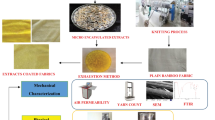Abstract
The bamboo yarn of Ne 40s was used for the preparation of the Gauze fabric. The physical properties such as areal density and stiffness of fabrics were measured. The fabric was then scoured and bleached as per the standard procedure using distilled water. Chitosan-sodium alginate, Calcium-sodium alginate polymer and their mixture were coated separately on the gauze structure to improve the antibacterial and wound healing property of the bandage. Scanning electron microscope (SEM) analysis was carried out to observe the uniform distribution of polymers in the samples. The antibiotic drugs were selected based on the antibiotic sensitivity test. The drugs such as Tetracycline hydrochloride (250 mg), Chloramphenicol (250 mg) and Rifampicin (250 mg) were immobilized on the polymer coated fabrics to increase the rate of wound healing and antibacterial activity. The drug loaded samples were subjected to drug release study for about four days in a static condition. The results show that good amount of drug was released during all the four days. Further, the antibacterial activity of the drug loaded and polymer coated samples were evaluated against S. aureus and Proteus bacteria. The results show excellent antibacterial activity.
Similar content being viewed by others
References
S. Rajendran and S. C. Anand, Ind. J. Fibre Text. Res., 31, 215 (2006).
F. C. Yanga, K. H. Wu, M. J. Liu, W. P. Lin, and M. K. Hu, Mater. Chem.Phys., 113, 474 (2009).
L. L. Balassa and J. F. Prudden, Academic Press; San Diego., 296 (1984).
R. Muzzarelli, G. Biagini, and A. Pugnaloni, Biomaterials, 10, 598 (1991).
N. R. Sudardshan, D. G. Hoover, and D. Knorr, Food Biotechnol., 6, 257 (1992).
S. W. Fang, C. F. Li, and D. Y. C. Shih, Food Protect., 56, 136 (1994).
Y. Qin, Text. Res. J., 75, 165 (2005).
Y. Qin and D. K. Gilding, Med. Device Technol., 7, 32 (1996).
A. I. Attwood, Br. J. Plast. Surg., 42, 373 (1989).
J. Sayag, S. Meaume, and S. Bohbot, J. Wound Care., 5, 357 (1996).
W. Paul and C. P. Sharma, Trends Biomater. Artif. Organs., 18, 18 (2004).
A. Varada Rajulu, R. Reddy, and K. Narasimha Chari, Ind. J. Fibre Text. Res., 21, 223 (1996).
E. R. Trotman, “Dyeing and Chemical Technology of Textile Fibres”, 5th ed., p.193, Charles Griffin and Company Ltd., London, 1990.
O. L. Shanmugasundaram, V. R. Giri Dev, and M. Madhusoothanan, Ind. J. Fibre & Text. Res., 31, 543 (2006).
A. Thomas, K. G. Harding, and K. Moore, Biomaterials, 21, 1797 (2000).
Author information
Authors and Affiliations
Corresponding author
Rights and permissions
About this article
Cite this article
Shanmugasundaram, O.L., Mahendra Gowda, R.V. Development and characterization of bamboo gauze fabric coated with polymer and drug for wound healing. Fibers Polym 12, 15–20 (2011). https://doi.org/10.1007/s12221-011-0015-6
Received:
Revised:
Accepted:
Published:
Issue Date:
DOI: https://doi.org/10.1007/s12221-011-0015-6




